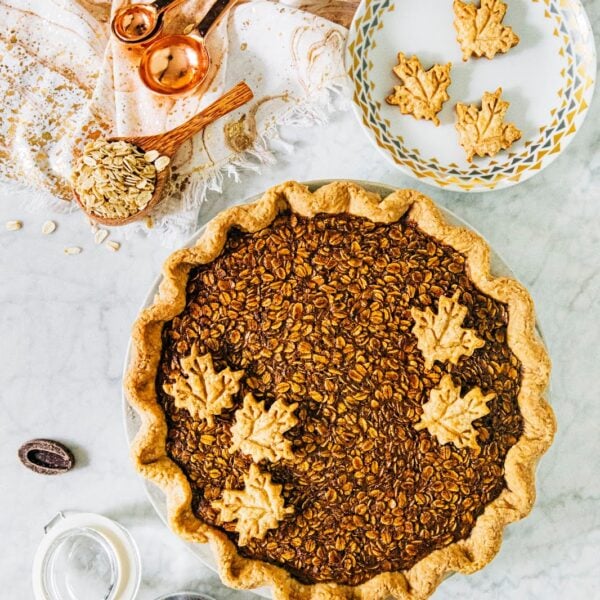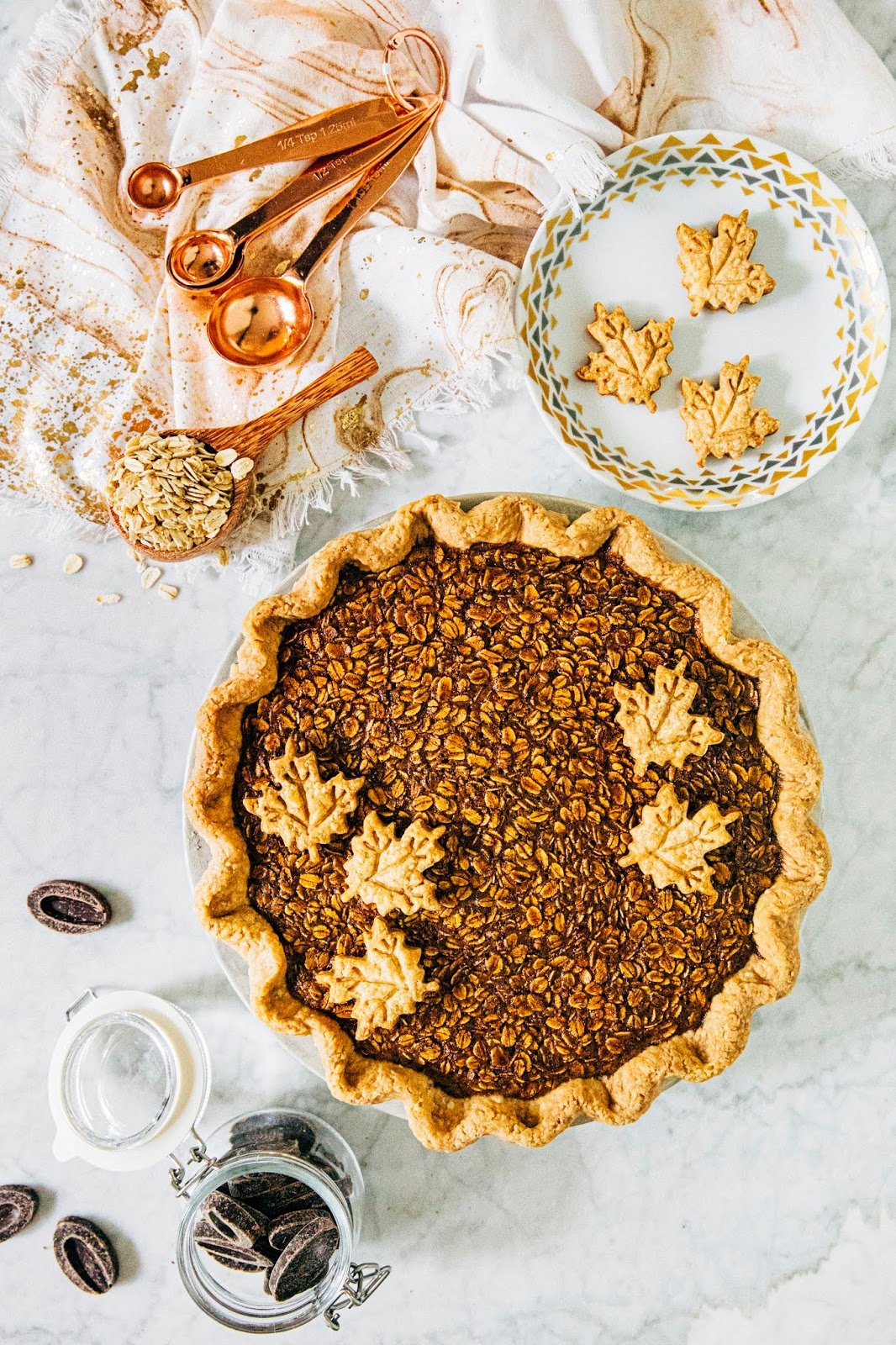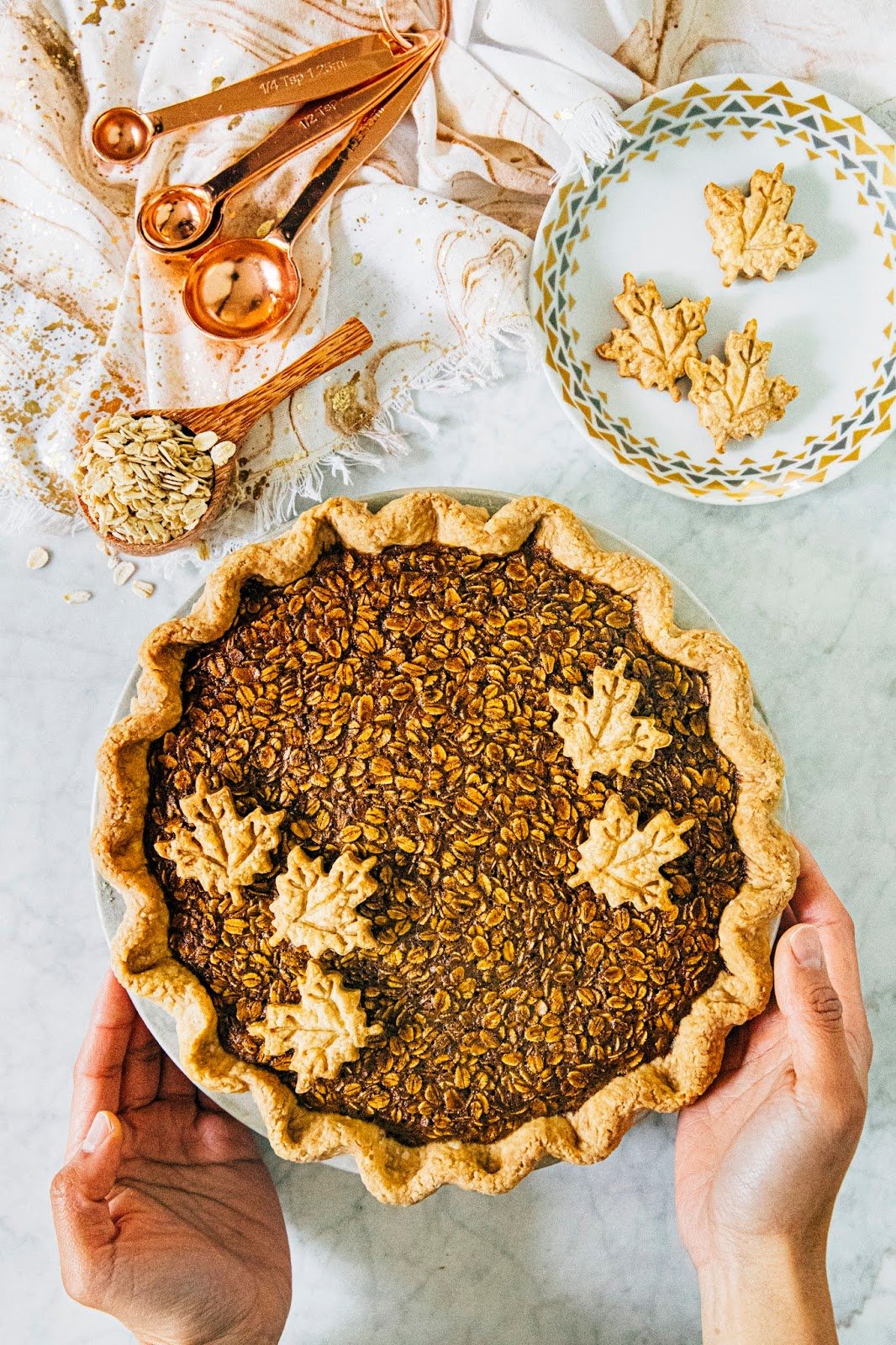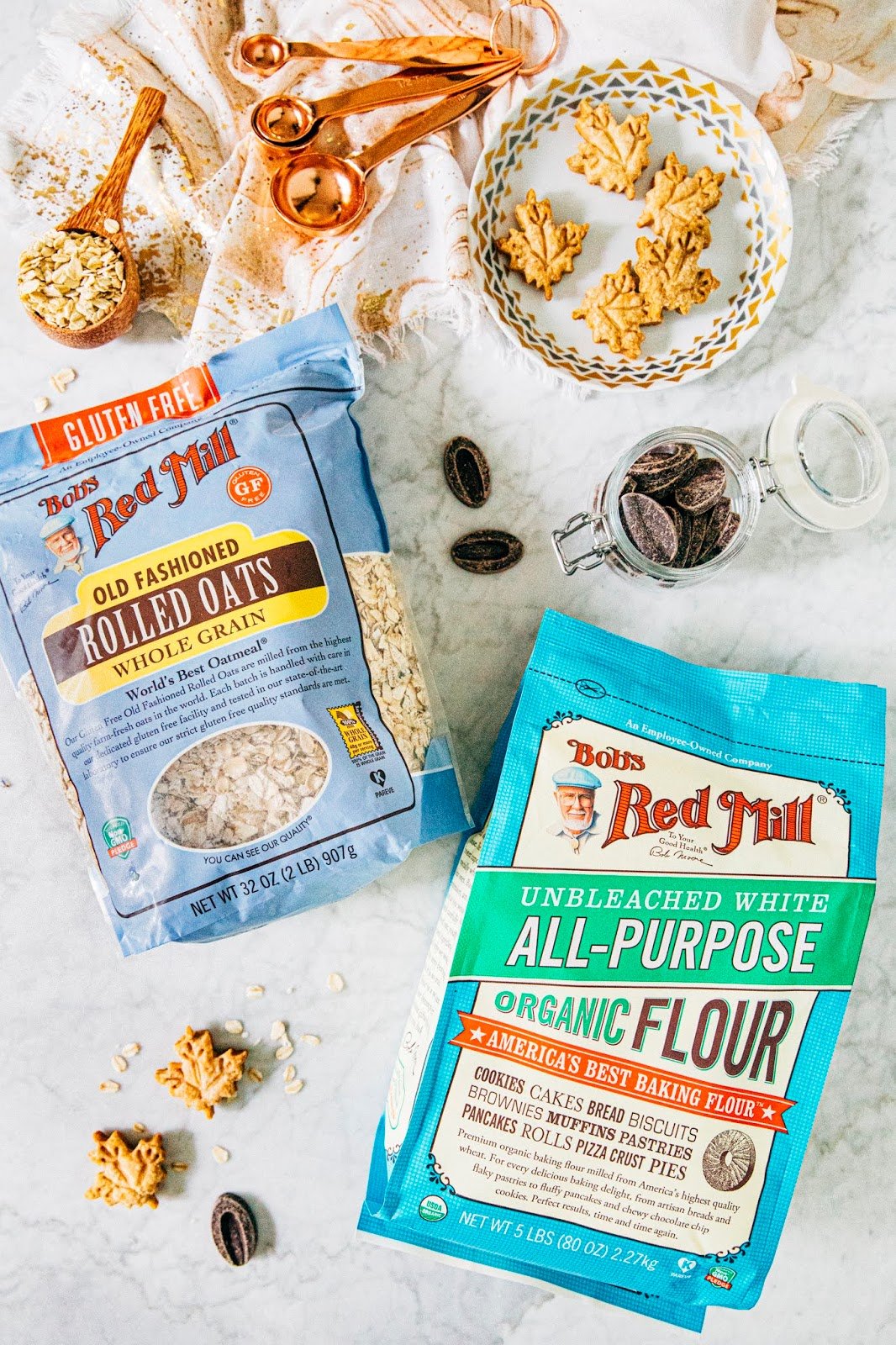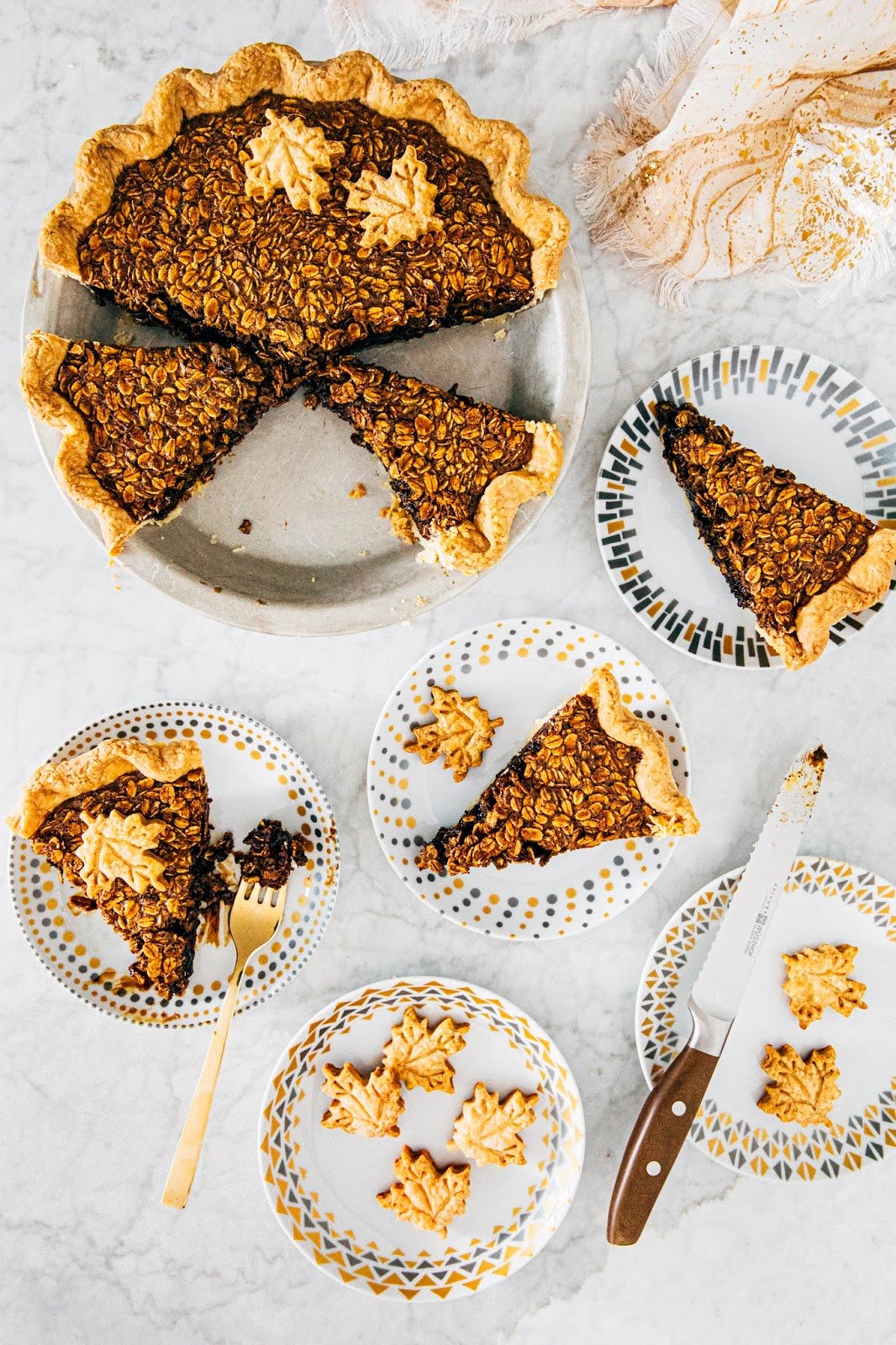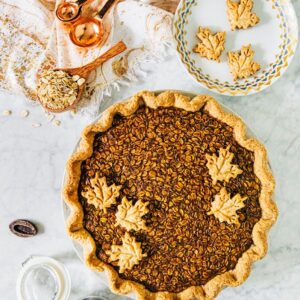If you’re looking for a unique and different Thanksgiving pie recipe, this black bottom oatmeal pie recipe is for you! First popularized by famed Brooklyn pie shop, Four & Twenty Blackbirds, this pie is inspired by the flavors of an oatmeal chocolate chip cookie—jump to the recipe! For even more flavor, be sure to use organic all-purpose flour and old-fashioned rolled oats from my sponsor, Bob’s Red Mill. As always, all thoughts and opinions are my own, and thank you for supporting the brands that keep the lights on at Hummingbird High!
Thanksgiving Pies
Every year, when Thanksgiving rolls around, I am faced with a dilemma. You see, I am not the world’s biggest fan of traditional Thanksgiving pies like pumpkin and sweet potato. There, I said it. Have I failed you as a food blogger? But I honestly find those types of pies too heavy and starchy, especially after a large meal of turkey and sides like stuffing and mashed potatoes. I could skip serving them completely, sure, but a Thanksgiving table feels incomplete without at least one pie.
So every Thanksgiving, I try and research “alternative” pies to make for the occasion. A few years ago, when we still had the tradition of making an Asian-style Thanksgiving (we served a roasted Chinese-style duck instead of Turkey), I made a matcha buttermilk pie instead. I’ve also experimented with substituting the pie crust for a tart shell instead, and purple sweet potatoes instead of traditional orange ones to lighten up the pie. They were all delicious (but definitely still on the heavy side, lol).
This year, I decided to bake a recipe off my baking bucket list: black bottom oatmeal pie.
What is black bottom oatmeal pie?
Okay, hold the phone. What exactly is black bottom oatmeal pie?
This particular recipe comes from a New York City pie shop called Four & Twenty Blackbirds. According to the story in their cookbook, back in the day, thrifty folks who couldn’t afford the pecans for pecan pie would substitute oats instead. Four & Twenty Blackbirds took one of these old-fashioned recipes and improved it by adding a layer of chocolate ganache at the base of the pie crust (hence the “black bottom”). Not only does the ganache prevent the pie crust from getting soggy, it also makes the entire pie taste like an oatmeal chocolate chip cookie, too. It’s absolutely delicious.
While making the oatmeal filling is fairly straightforward, the process for making the crust is a little more complicated. You’ll need to blind bake the pie crust—check out my guide below on how to blind bake a pie crust (featuring some pie-making FAQs!), along with my baker’s notes on how to make the best black bottom oatmeal pie ever!
How to Blind Bake Pie Crust
What is blind baking a pie crust?
Blind baking, also known as par-baking or pre-baking, is when pie dough is formed into a crust and cooked without the filling for a short period of time. After the crust is blind baked, it is then baked a second time, but this time with the filling in place. This is because some fillings bake faster than the crust in the oven—if you have a filling that bakes up fast, you’ll either end up with a raw pie dough that needs more time in the oven OR a filling that’s overdone. Baking the crust without the filling first and then AGAIN with the filling ensures that you’ll have the perfect pie, no matter what.
When do you need to blind bake a pie crust?
Usually, recipes do a good job and tell you whether or not the pie crust needs to be blind baked. But if your recipe somehow fails to do this, a general rule of thumb is this: pie crusts filled with custard or cream need to be blind baked, whereas pie crusts filled with fruit and other solids can skip the process.
Why do you use pie weights when you blind bake a pie crust?
A recipe for blind baking pie usually instructs you to line the unbaked crust with foil or parchment and then pour pie weights into the center. You then bake the pie with the weights.
The pie weights act as “filling” that will help hold the crust in shape; without it, the crust will either puff up or slide down the sides of the pan as it bakes. You can buy specialty pie weights in a cooking shop or online; I prefer the ceramic ball weights to the metal chains because I find that heavier weights help the crust hold its shape better. In a pinch, you can also use dried beans, rice, or even coins from a jar of spare change.
What temperature should you blind bake a pie crust?
Traditionally, most recipes instruct you to bake the pie crust at a high heat like 425°F to “set” the dough by encouraging the butter to melt quickly. If the butter melts quickly, more steam evaporates all at once, causing the flaky texture that’s desired in pie crust. However, I found that baking it at those temperatures causes the crust to shrink and lose its shape. Instead, I like to bake mine at a lower temperature for a longer period of time—you can read more about why in my cookbook, Weeknight Baking.
How long to blind bake a pie crust?
It depends on the temperature you bake the crust at (see previous question). If you choose to bake the pie at a higher temperature, you’ll usually need to blind bake for around 20 to 25 minutes. With my method, you’ll need to add an additional 10 to 15 minutes and bake for 35 minutes. There are also some recipes in which you’ll need to blind bake the pie FULLY because the filling itself doesn’t need to be baked—recipes for ice cream or pudding pies are an example. If you’re blind baking the pie fully, you’ll likely need to add more time to the approximations I just gave you. Again, I wouldn’t worry about this too much; most recipes will instruct you accordingly!
Best Black Bottom Oatmeal Pie Recipe Tips
-
- While the pie filling recipe can be credited to Four & Twenty Blackbirds, the pie dough recipe actually comes from my cookbook, Weeknight Baking. Unlike most recipes that instruct you to make the pie dough in a food processor or by hand with a pastry cutter, I instruct you to make the pie dough in a stand mixer. IMO, it’s the best and easiest way to make pie dough! The recipe is technically for a 9-inch double-crusted pie; you’ll need to divide the dough into ¾ portions and ¼ portions. The larger portion will be used to make the bottom crust; you’ll need more dough than normal to help your pie crust keep its shape when blind baking. Reserve the final ¼ of dough to make pie dough cookies to decorate the pie with!
-
- Making pie is always a process: first you’ll need to make the dough, chill it, roll it out and shape it onto your pie plate, then chill it again before baking. It’s even worse when blind baking since you’ll need to bake the pie TWICE. To make sure you’re not stuck in the kitchen for the entire day, I’ve divided the recipe up over 2 days so that you’ll only be working for half an hour at a time (this is literally the premise of Weeknight Baking, lol). You can also just do everything all in one day, but I’m warning you that doing so turns this recipe into an ALL-DAY baking project.
- This recipe calls for dark corn syrup; I actually didn’t have any in my pantry, so I ended up using a can of Lyle’s Black Treacle that I’d been hoarding from my last trip to London. So if you don’t live in the US (where corn syrup is much more of a thing), take note: treacle and molasses can be substituted for the dark corn syrup in this recipe.
Get the Recipe: Black Bottom Oatmeal Pie
Ingredients
For the Stand Mixer All-Butter Pie Dough
- 6 Tablespoons (3 ounces or 85 grams) very cold water
- 1 Tablespoon apple cider vinegar
- 1 cup ice
- 1 cup (8 ounces or 227 grams) very cold unsalted butter
- 2 ½ cups (11.25 ounces or 319 grams) Bob’s Red Mill Organic Unbleached White All-Purpose Flour, plus more for assembly
- 1 Tablespoon granulated sugar
- 1 teaspoon kosher salt
Assembly
- 1 large egg white
- 1 teaspoon water
For the Black Bottom Oatmeal Filling
- 4 ounces (113 grams) dark chocolate (between 60% to 70% cacao), chopped into ¼- to ½-inch pieces
- ¼ cup (2 ounces or 57 grams) heavy cream
- ¾ cup tightly packed (5.65 ounces or 160 grams) dark brown sugar
- 5 Tablespoons (2.5 ounces or 71 grams) unsalted butter, melted
- ¼ teaspoon ground ginger
- ½ teaspoon kosher salt
- 1 cup (11.25 ounces or 319 grams) dark corn syrup (see baker’s notes for substitutions)
- 2 teaspoons apple cider vinegar
- 1 teaspoon pure vanilla extract
- 4 large eggs
- 1 ½ cups (5.25 ounces or 149 grams) Bob’s Red Mill Old Fashioned Rolled Oats
Instructions
Day 1: Make the Pie Dough and Prep for Blind Baking
- In a large liquid measuring cup, whisk together the water and vinegar. Add the ice and whisk. Refrigerate while you prep the rest of the ingredients.
- Cut the butter into 1-inch cubes and place them in a small bowl. Freeze while you prep the rest of the ingredients.
- In the bowl of a stand mixer fitted with the paddle attachment, combine the Bob’s Red Mill Organic Unbleached White All-Purpose Flour, sugar, and salt. Beat on low until just combined, about 15 seconds. Add the butter all at once and beat on low until the mixture has the texture of coarse meal, with pea-sized pieces of butter throughout, about 3 minutes.
- Remove the ice water mixture from the refrigerator. With the mixer on low, add 6 tablespoons of liquid from the ice water mixture. Beat on low for 2 to 3 minutes, or until the dough clumps around the paddle and/or the sides of the bowl. If the dough seems too dry, add more liquid from the ice water mixture 1 teaspoon at a time.
- Tip the dough out onto a lightly floured counter with a rubber spatula. Quickly knead the dough into a rough ball. Divide the dough into a ¾ portion (around 16.5 ounces) and a ¼ portion (around 5.5 ounces). Wrap each portion tightly in plastic wrap and flatten into a small disc. Refrigerate for at least 1 hour.
- After 1 hour, remove the larger portion of dough from the refrigerator, unwrap, and place on a lightly floured counter. Give the dough a feel. Workable pie dough in disc form feels like slightly-colder-than-room-temperature butter—it’s still pretty solid but gives a little when poked. If you find your dough feels like a rock, it’s too cold. But we can fix this! Give it a few whacks with a rolling pin, rotating the disc after every whack to ensure it’s flattening evenly. Let it sit for a minute or two, then test it again. If it’s still too solid, keep whacking it until you’re able to roll it out with some resistance against your rolling pin (you want the dough to feel a little bit like saltwater taffy when you roll it out). If it’s too warm, the dough will start sticking to the counter—if this happens, try dusting the dough and counter with more flour. If that doesn’t help, refrigerate the dough for 15 minutes, then try again.
- Roll out the dough, starting with your rolling pin in the center of the disc and moving outward. Rotate the dough with every other roll until you have an even circle 2 to 3 inches larger than your pie pan. Transfer the rolled out dough onto the pie pan—you should have at least 2 inches of dough overhanging over the edge of the pie pan. Fold the overhanging dough onto itself, aligning the edge of the dough to the inner edge of the pie pan. Pinch along the fold all the way around to create a firm edge. Don’t worry if it looks big; the crust will shrink a little bit in the oven, so bigger is better in this case.
- Dust your fingers with Bob’s Red Mill Organic Unbleached White All-Purpose Flour. Take your thumb and press it into the folded overhang, using your thumb and index finger on the opposite hand to pinch around your thumb to create your first crimp. Repeat, crimping the dough around the entire pan, flouring your hands as necessary to prevent the dough from sticking.
- Once the border is crimped, use a fork to prick holes across the bottom and sides of the pie crust. Cover loosely with plastic wrap and freeze overnight.
- Remove the smaller portion of dough from the refrigerator, unwrap, and place on a lightly floured counter. Follow the instructions above to soften and roll out the dough into a slab around ¼ inch thick—the shape and the size of the slab doesn’t matter since you’ll be using this dough to stamp out cookies. Scoot the slab onto a sheet of parchment paper.
- Use your favorite cookie cutters to cut out shapes, placing the cookies at least 1 ½ inches apart on a parchment-lined half sheet pan. The dough should still be cool and firm to the touch; if you find the cookies sticking to the counter, place the pie dough slab in the freezer for 10 minutes before cutting out more shapes, using the parchment paper as handles to help transfer the slab into the freezer.
- Cover the sheet pan with the cookies loosely with plastic wrap and place in the refrigerator to chill overnight.
Day 2: Blind Bake the Pie, Make the Black Bottom Oatmeal Pie Filling, and Bake Again!
- First, blind bake the pie: position a rack in the center of the oven and preheat the oven to 350°F. Line a sheet pan with parchment paper and place the frozen crust in the center of the pan. Cover the crust with foil, making sure the crimped edges are completely covered and that there are no gaps between the foil and the crust. Fill with pie weights and spread them out so they are more concentrated around the edges of the crust.
- Bake for 35 minutes. While the crust is in the oven, make the egg wash: In a small bowl, whisk together the egg, water, and salt.
- Remove the sheet pan from the oven, keeping the oven on. Carefully lift out the pie weights and foil. Use a pastry brush to coat the bottom and sides of the pie crust (but not the crimped border) with a thin layer of egg wash. Bake, uncovered, for an additional 5 minutes. Cool on a wire rack for at least 30 minutes before you make the pie filling.
- Next, make the ganache layer: place the dark chocolate in a small heatproof bowl. Bring the heavy cream just to a heavy boil over medium heat in a small, heavy-bottomed saucepan. Remove from heat and immediately pour over the chocolate, then place a heatproof plate over the bowl to create a makeshift lid. Let sit, undisturbed, for 5 minutes.
- Remove the plate. Whisk slowly but steadily until the ganache is thick, smooth, and shiny. Scrape the ganache into the cooled pie shell and spread evenly over its bottom and sides with an offset spatula. Place the shell in the freezer to set the ganache while making the filling.
- Position two racks in the oven, placing one in the upper third and the second in the lower third of the oven. Preheat to 350°F.
- Next, make the oatmeal filling: in a large bowl, whisk together the sugar, melted butter, ginger, and salt. Add the corn syrup, apple cider vinegar, and vanilla, whisking to combine. Add the eggs one at a time, whisking well after each addition. Use a rubber spatula to mix in the Bob’s Red Mill Old Fashioned Rolled Oats.
- Place the ganache-coated pie shell on a parchment-lined half sheet pan and pour in the filling. Place the sheet pan with the pie on the lower third rack, and the sheet pan with the pie crust cookies on the upper third rack (yep—you’ll be baking the cookies straight from the fridge!). Bake for 25 minutes. After 25 minutes, remove the sheet pan with the cookies (the cookies will be golden brown) and place on a wire rack. Transfer the sheet pan with the pie to the upper third rack and bake for an additional 30 minutes, or until the edges are set and the center is slightly firm to the touch but still wobbles ever so slightly in the center. Cool completely on the wire rack before garnishing with the pie crust cookies; serve slightly warm or at room temperature. The pie will keep refrigerated for 3 days or at room temperature for 2 days.

